In-Depth Guide for Base Wall Deterioration at a Stairway
This past week, we started looking at a particular case study of a stairway with exposed exterior brick masonry. This stairway is a typical pretty common type of configuration and layout in Washington DC. There are examples of extreme deterioration, which could have been avoided through routine maintenance, upkeep repointing and tuckpointing.
The building corner, where the stair meets the pedestrian sidewalk, at grade, has deteriorated to the point that the bricks have actually become dislodged, not through a typical stair-step cracking or lateral deflection type of deterioration, just from neglected repointing.
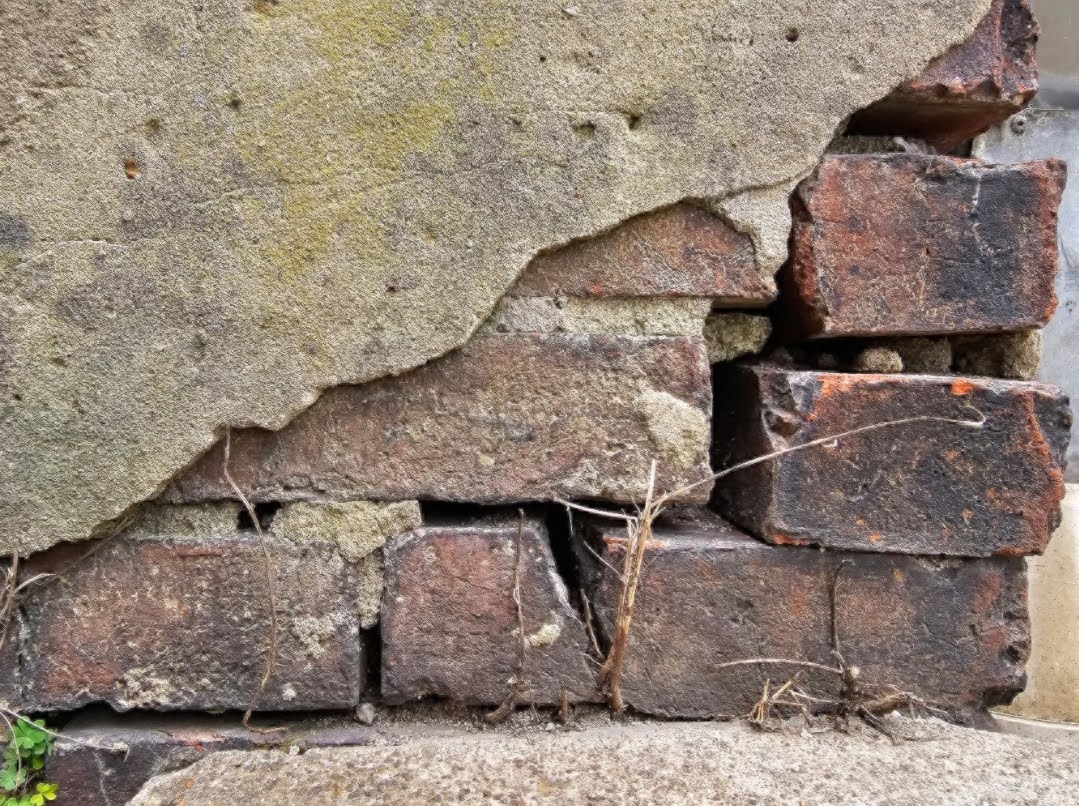
The acute deterioration of historic lime mortar, particularly at the base of walls adjacent to below-grade exterior stairways, is a process influenced by a variety of chemical, physical, and environmental factors. Deterioration at locations and configurations of buildings like this generally happens faster than most other parts of the building. This accelerated decay at the wall’s base is a result of the unique conditions present in this microenvironment.
To understand the deterioration process, we look at the composition of historic lime mortar. Traditional lime mortar consists primarily of:
- Lime (calcium hydroxide, Ca(OH)2)
- Sand (silica, SiO2)
- Water (H2O)
The lime acts as the binder, while sand provides the aggregate which you can think of as the bulk and structure. Unlike modern Portland cement, lime mortar remains somewhat porous and flexible, allowing for slight movements in the masonry structure.
The curing and hardening of lime mortar occur through a process called carbonation. This involves the reaction of calcium hydroxide with carbon dioxide from the air:
Ca(OH)2 + CO2 → CaCO3 + H2O
Portland mortar, by comparison, hardens and cures more through hydration, not carbonation. This difference really happens all the way down at the chemical level. It’s a faster process/ reaction which leads to a faster cure time which means the construction is ready much faster from a load and use perspective. In fact, in the curing of Portland mortar, the carbonation reaction is actually considered unwanted and or potentially a negative aspect to the chemical process. (It reduces alkalinity which can lead to the deterioration of steel reinforcement, carbonation can spur micro-cracking which is considered a natural reaction in curing but still unwanted, and carbonation is more influenced by the surrounding environment and therefore less predictable. In the future, here on our website, we may post a separate blog article just to examine and further explain the differences between the hydration vs. carbonation process.)
This reaction converts the soft, workable lime into hard calcium carbonate (limestone). However, this process is slow and can continue for decades, contributing to the mortar’s ability to “self-heal” small cracks.
We looked at this deciduous tree growing out of the cracks between the historic brick wall and the concrete stairway. This tree took root, in the beginning, in what started as a very small crack. Simple upkeep and maintenance can avoid gaps and cracks between mortar and masonry which can allow for biocolonization and plant growth which will drastically increase the speed of further deterioration.
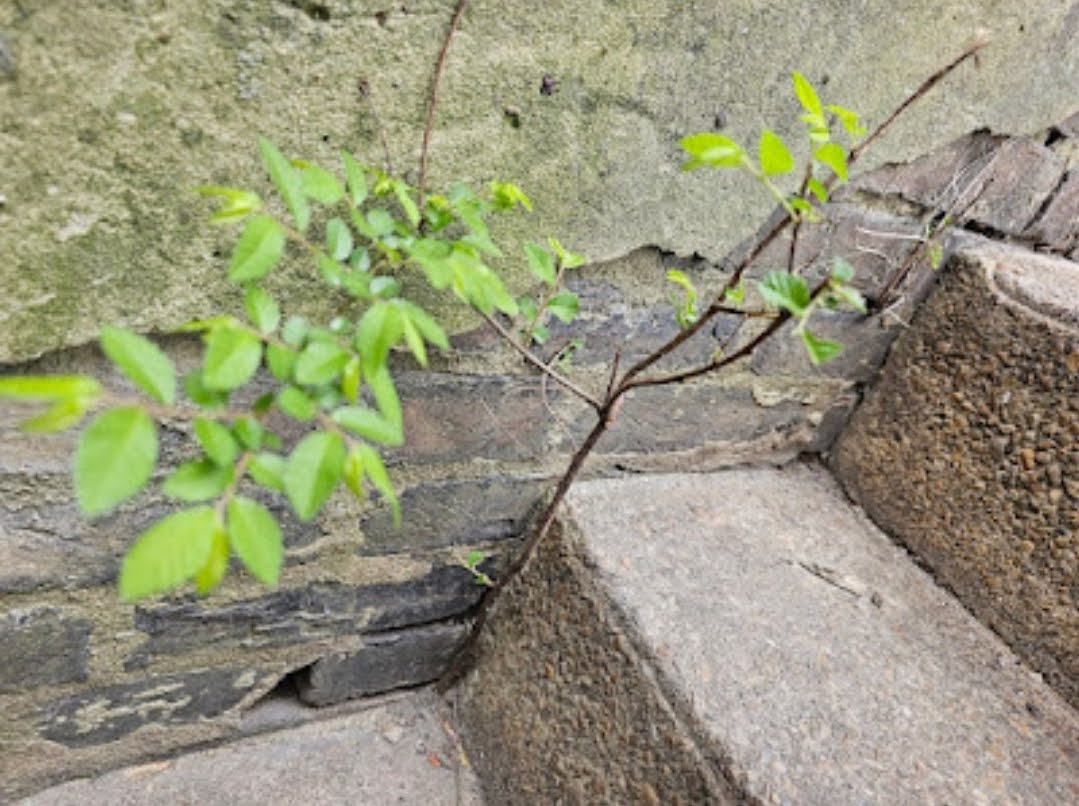
Several factors contribute to the accelerated deterioration of lime mortar at the base of walls near below-grade stairways:
- a) Moisture Exposure: The base of the wall is more susceptible to prolonged moisture exposure due to:
- Splash-back from rain hitting the stairway or ground
- Snow accumulation against the wall
- Rising damp from the soil
Constant moisture weakens the mortar by dissolving some of its components and promoting harmful chemical reactions. These chemical reactions, with prolonged moisture, have extended periods of time to react slowly.
- b) Freeze-Thaw Cycles: In regions with cold climates, the moisture trapped in the mortar can freeze and expand, creating internal stresses. Repeated freeze-thaw cycles can cause significant damage, especially in areas prone to frequent wetting and drying.
- c) Salt Crystallization: Salts from the soil, de-icing agents, or even within the masonry materials themselves can be drawn into the mortar through capillary action. As water evaporates, these salts crystallize, expanding and exerting pressure within the pores of the mortar. This process, known as subflorescence, can cause significant damage over time.
- d) Biological Growth: The damp environment at the base of the wall provides ideal conditions for algae, lichens, and moss growth. These organisms can retain moisture against the wall and produce acids that erode the mortar.
- e) Carbon Dioxide Concentration: CO2 levels are often higher near the ground due to decomposition of organic matter and reduced air circulation. This can accelerate the carbonation process, potentially leading to over-carbonation and weakening of the mortar.
- f) Physical Abrasion: In the case of stairways, foot traffic and maintenance activities (like snow shoveling) can cause physical wear on the mortar joints.
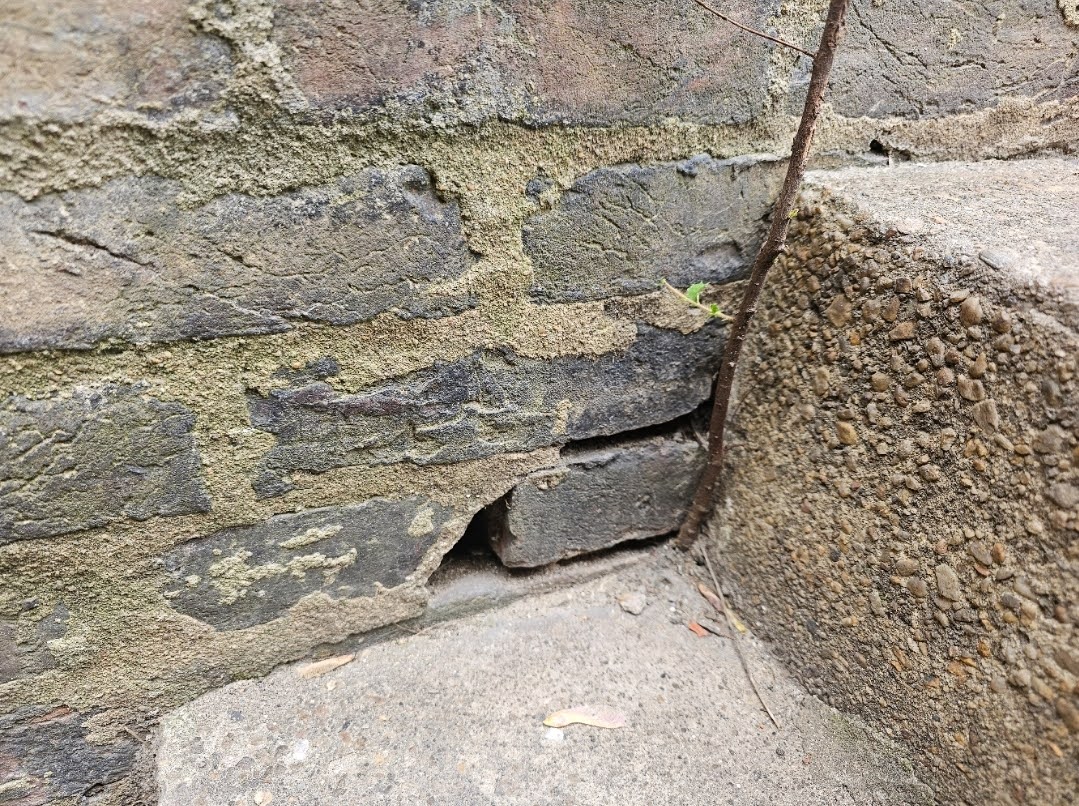
The deterioration of lime mortar involves several chemical processes:
- a) Dissolution: Water, especially when slightly acidic due to dissolved CO2 or pollutants, can dissolve the calcium carbonate in the mortar:
CaCO3 + H2O + CO2 → Ca(HCO3)2
This bicarbonate is more soluble and can be washed away, leaving voids in the mortar.
- b) Sulfate Attack: If sulfates are present (often from pollution or soil), they can react with components of the mortar to form expansive compounds like ettringite:
3CaO·Al2O3 + 3CaSO4·2H2O + 26H2O → 3CaO·Al2O3·3CaSO4·32H2O
This expansion can cause cracking and disintegration of the mortar. The problem is particularly bad in later lifecycle stages of the mortar and or cementitious assemblies because it can lead to cracking which in result leads to further deterioration.
- c) Carbonation-Induced Shrinkage: As carbonation progresses, there’s a slight reduction in volume, which can lead to shrinkage cracks, especially in areas subject to stress.
- d) Leaching: The constant presence of water can lead to the leaching of calcium hydroxide from the mortar, weakening its structure.
From an engineering perspective, the deterioration of mortar at the base of walls presents several challenges:
- a) Structural Integrity: As mortar deteriorates, it loses its ability to bind the masonry units together, potentially compromising the wall’s structural integrity.
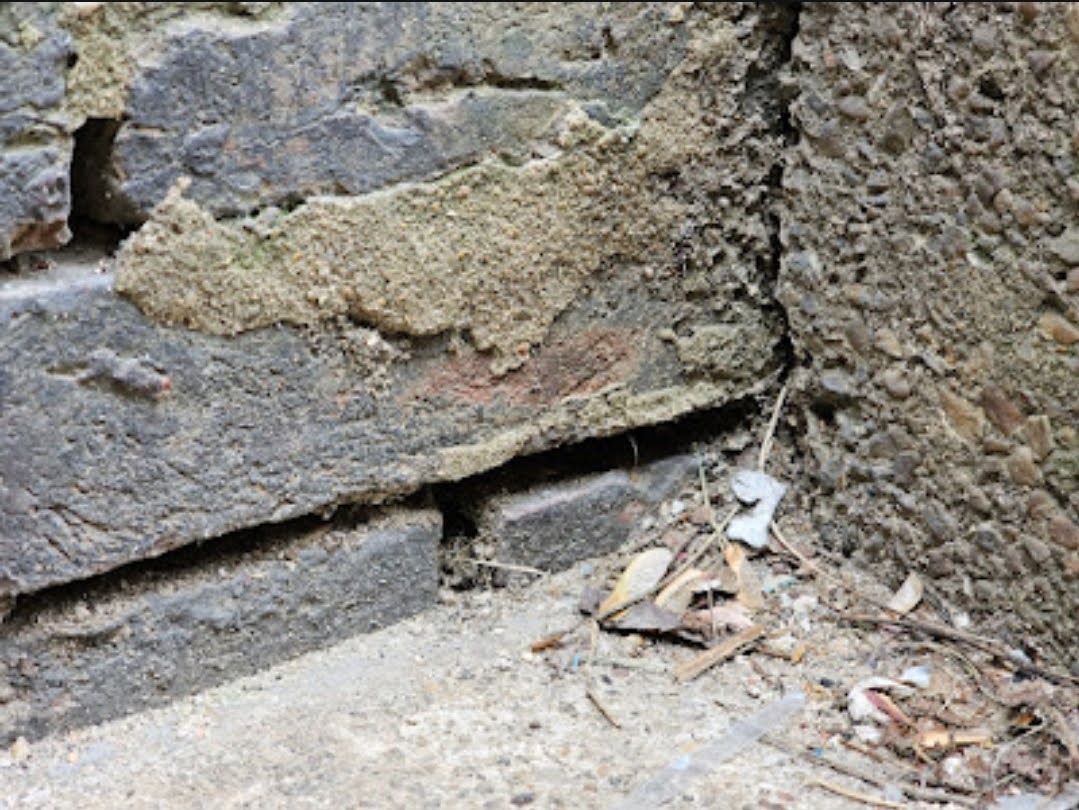
- b) Moisture Barrier Failure: Deteriorated mortar joints can allow water to penetrate deeper into the wall, leading to further damage to interior finishes and structural elements. One of the main purposes of the exterior walls of our buildings and homes is to keep the weather out of the building and when water starts leaking into the building, it’s simply a major problem.
- c) Thermal Performance: Voids in the mortar can create pathways for air and moisture movement, affecting the wall’s thermal performance and energy efficiency.
- d) Aesthetic Concerns: Visible deterioration and biological growth can detract from the historical and aesthetic value of the structure.
- The Cumulative Effect
The deterioration of lime mortar is often a cumulative and self-reinforcing process. As small voids form, they trap more moisture, leading to further dissolution, freeze-thaw damage, and salt crystallization. This, in turn, creates larger voids, accelerating the decay process.
- Mitigation Strategies
Understanding these scientific and engineering principles allows for the development of effective mitigation strategies:
- a) Proper Drainage: Ensuring good drainage away from the wall base can significantly reduce moisture exposure.
- b) Breathable Treatments: Using breathable water-repellent treatments can help protect the mortar while still allowing moisture to escape.
- c) Regular Maintenance: Periodic repointing with appropriate lime mortar can help maintain the integrity of the joints.
- d) Environmental Control: In some cases, controlling the immediate environment (e.g., through the use of sacrificial rendering) can help protect the original fabric.
- e) Compatible Materials: When repairs are necessary, using materials compatible with the original lime mortar is crucial to prevent accelerated decay due to differential properties.
The unique conditions in this microenvironment, at below grade exterior stairs: increased moisture, higher CO2 levels, salt exposure, and physical stresses – create a perfect storm for historic brick mortar degradation. By understanding these principles, we can develop more effective strategies for preserving these historic structures.
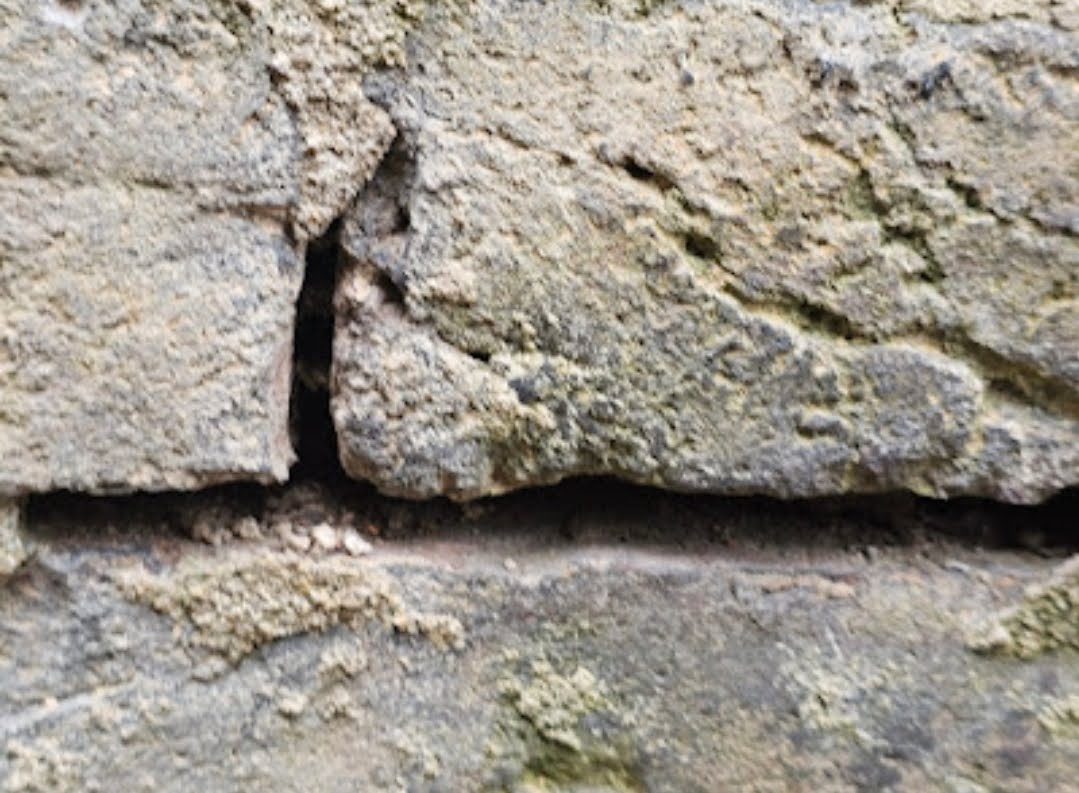
If you are looking for a masonry restoration contractor that takes historic preservation seriously, reach out to us. Our company can help.
You can reach us by telephone at (202) 796-7644 and you can reach us by email from the contact form on our website at https://duponttuckpointingmasonrydc.com/contact-us/.




